
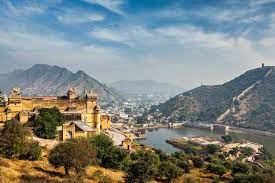
Perched majestically atop a rugged hilltop overlooking the bustling city of Jaipur, Amer Fort stands as a timeless testament to the grandeur and valor of Rajasthan's Rajputana heritage. Built in the 16th century by Raja Man Singh I, this formidable fortress boasts a harmonious blend of Hindu and Mughal architectural styles, featuring intricate marble carvings, ornate mirror work, and expansive courtyards. Visitors are transported back in time as they traverse the fort's labyrinthine passages, adorned with beautiful frescoes and adorned with elaborate lattice windows known as jharokhas. The fort's strategic location offers breathtaking panoramic views of the surrounding Aravalli Hills and the placid Maota Lake below. Amer Fort not only captivates with its architectural splendor but also regales visitors with tales of valor and romance, making it a must-visit destination for those seeking to immerse themselves in the rich tapestry of Rajasthan's royal legacy.
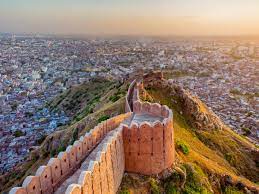
Nahargarh Palace, perched atop the rugged Aravalli hills overlooking the vibrant city of Jaipur, offers a glimpse into the opulent lifestyle of Rajasthan's royalty. Built in the 18th century by Maharaja Sawai Jai Singh II, this majestic palace served as a retreat for the kings and queens of Jaipur. Steeped in history and adorned with exquisite Rajput and European architectural elements, Nahargarh Palace boasts sprawling courtyards, intricately carved balconies, and ornate frescoes depicting mythological tales. The palace's strategic location affords panoramic views of Jaipur's skyline, making it a favorite spot for tourists to witness breathtaking sunsets and capture memorable photographs. Today, Nahargarh Palace stands as a cultural landmark and a testament to the grandeur and splendor of Rajasthan's royal heritage, inviting visitors to step back in time and immerse themselves in the regal ambiance of a bygone era.
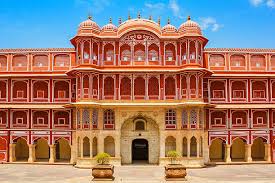
City Palace, an architectural masterpiece located in the heart of Jaipur, Rajasthan, stands as a symbol of the city's rich cultural heritage and royal legacy. Built in the 18th century by Maharaja Sawai Jai Singh II, the palace complex encompasses a magnificent blend of Rajput, Mughal, and European architectural styles, showcasing ornate gateways, intricate lattice work, and opulent courtyards. Visitors are greeted by the towering facade of the Chandra Mahal, the residence of the erstwhile royal family, adorned with delicately painted ceilings and luxurious interiors. The palace also houses a museum that showcases an impressive collection of royal artifacts, including weapons, textiles, and artworks, offering insight into Jaipur's regal past. As one of the most iconic landmarks of the Pink City, City Palace continues to enchant visitors with its grandeur, elegance, and timeless allure, serving as a living testament to Rajasthan's royal heritage.
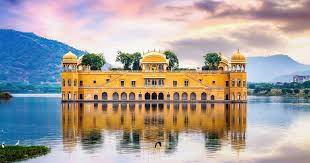
Jal Mahal, an architectural marvel nestled amidst the serene waters of Man Sagar Lake in Jaipur, Rajasthan, exudes an aura of timeless beauty and elegance. Built in the 18th century by Maharaja Madho Singh I, this "Water Palace" is a mesmerizing blend of Rajput and Mughal architectural styles. Rising from the shimmering waters, Jal Mahal's red sandstone facade stands in stark contrast against the azure hues of the lake, creating a picturesque sight that captivates all who behold it. While the palace's lower levels remain submerged in the lake, its upper floors boast intricately carved balconies, ornate archways, and exquisite floral motifs, offering a glimpse into the opulent lifestyle of Rajasthan's royalty. Today, Jal Mahal serves as a popular tourist attraction, drawing visitors with its serene ambiance, stunning views, and timeless charm, making it an integral part of Jaipur's architectural heritage.
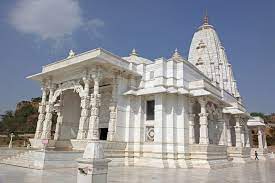
Birla Mandir, also known as the Laxmi Narayan Temple, stands as a radiant symbol of spirituality and architectural splendor in Jaipur, Rajasthan. Constructed in pure white marble by the renowned Birla family in 1988, this majestic temple offers a serene oasis amidst the bustling cityscape. Dedicated to Lord Vishnu and Goddess Lakshmi, the temple's intricate carvings, ornate domes, and exquisite sculptures reflect the finest craftsmanship of traditional Indian architecture. As visitors step into the temple complex, they are greeted by a sense of tranquility and devotion, amplified by the soul-stirring chants and the fragrance of incense. The temple's tranquil surroundings and breathtaking beauty make it a revered destination for both worshippers and tourists alike, inviting all to immerse themselves in a spiritual journey of peace, harmony, and divine grace.
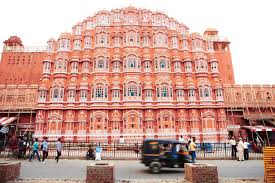
Hawa Mahal, the iconic "Palace of Winds" in Jaipur, Rajasthan, stands as a mesmerizing architectural marvel that embodies the city's rich heritage and cultural legacy. Built in 1799 by Maharaja Sawai Pratap Singh, this stunning five-story palace is renowned for its distinctive facade adorned with intricately carved windows, or "jharokhas," which resemble the honeycomb of a beehive. Designed to allow royal women to observe street festivities while maintaining their privacy, Hawa Mahal's lattice windows also serve as natural air-conditioners, allowing cool breezes to flow through the palace during hot summer days. As sunlight filters through the delicate screens, casting mesmerizing patterns across the interior, visitors are transported back in time to an era of regal grandeur and artistic brilliance. Hawa Mahal stands as a timeless symbol of Jaipur's architectural splendor and cultural richness, enchanting visitors with its ethereal beauty and historical significance.
